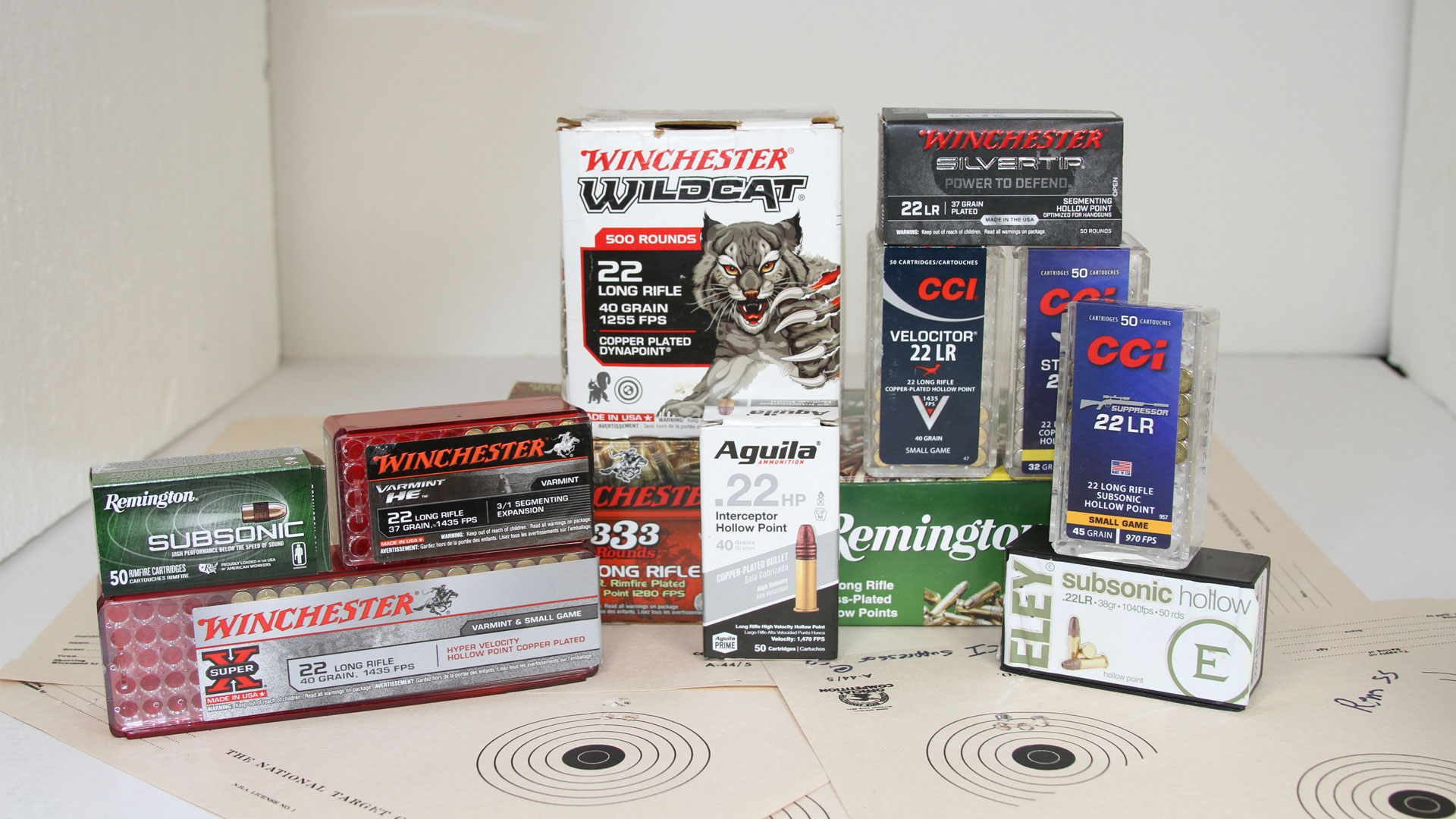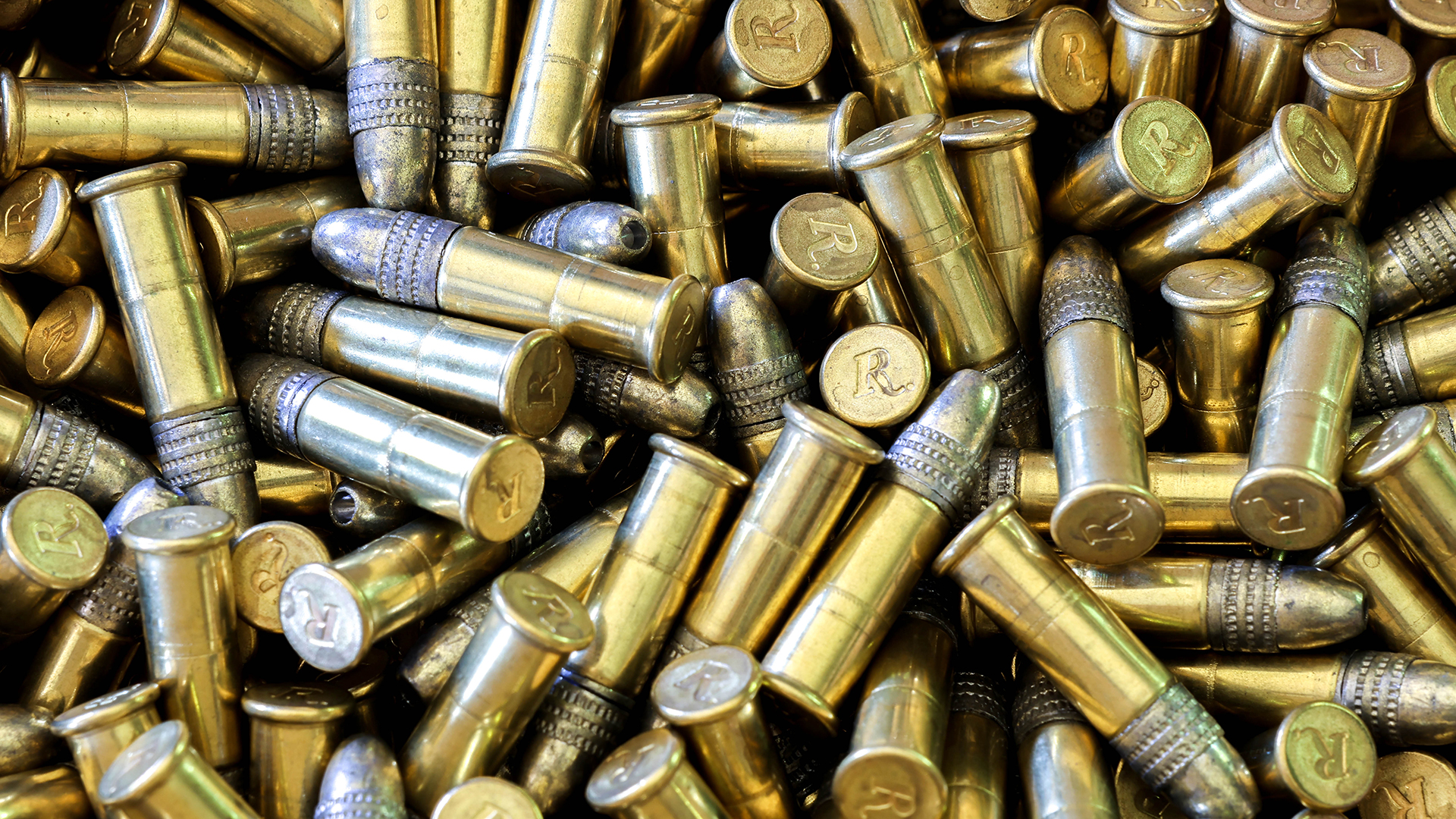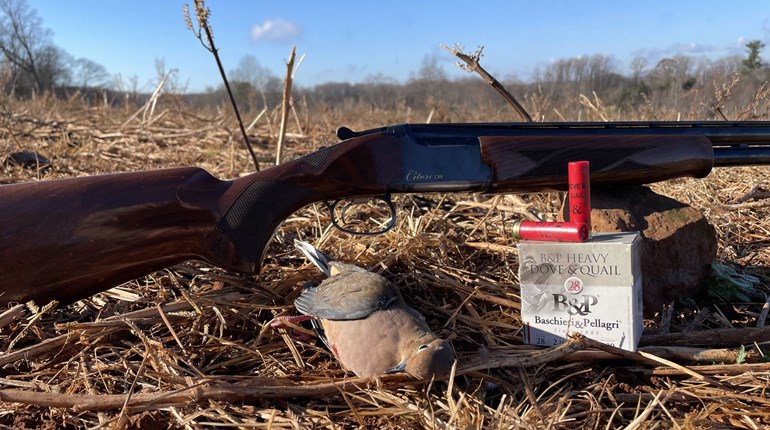
“A rigid, one-size-fits-all approach usually ends up fitting no one.” Attributed to Patrick Lencioni, an American author and orator, his quote is applicable beyond the basics of business about which he spoke. In fact, it can be related to hunting. Here’s how: varminters and small-game hunters, as well as those who forfend roaming, opportunistic predators on their homestead, often recruit a single .22 LR load for all tasks. Ostensibly, this makes sense, right? After all, how different can .22 LR ammunition be? The answer is: “markedly.” Sure, there is copious crossover, however, careful load selection typically results in enhanced results when afield.
This raises the question: “How do you know which .22 LR hunting load is best suited for you?” The information found below will help you discover the answer, so read on.

This & That of .22 LR Ammunition
One hundred eight results. That’s how many options online retailer MidwayUSA listed for “22 Long Rifle” at the time of this writing. With so many options, it can seem daunting to narrow the field and select the one; it doesn’t have to be. Before delving into categories of .22 LR loads, let’s examine frequent design features.
Outside of lead-free options—which utilize amalgamations of tin, copper and/or polymer in their construction—most .22 LR bullets are crafted with varying compositions of lead-alloy; some are harder and thus don’t expand, or do so in a limited fashion. This is mostly found in round-nose target/plinking bullets.

For small-game and predator hunting, as well as varminting and pest control, hollow-points and/or segmenting bullets are essential. Projectiles of these designs have all-but-guaranteed expansion at practical ranges, and thus the full-metal-jacket (FMJ) effect isn’t likely. The result: faster expiration. What’s more, bullets that fracture (especially) or upset upon impact displace more of the projectile’s energy on-target, and thus the opportunity for ricochet is lessened. Still, hunters must be keenly aware of their targets and what is found behind it. Want to lose hunting permission quickly? Put a rimfire bullet through a center pivot irrigation system, piece of farm equipment, etc.
Oftentimes, the projectiles of .22 LR ammunition are brass, nickel or copper plated (a.k.a. “washed”). Newer yet is the use of polymer in lieu of one of the aforementioned metals. Besides helping keep a cleaner barrel, the treatment assists with combatting lead buildup in a sound suppressor, too—a real nuisance. Ammunition featuring plated bullets is usually higher priced, but the upcharge shouldn’t be an issue unless you spend many workdays’ time sniping prairie dogs or are especially frugal. Top-tier ammunition featuring non-plated bullets often have a wax or wax-like lubricant. While it’s a non-issue in small quantities and temperate conditions, under a sweltering summertime sun the rounds can become nigh impossible to grasp and load in a well-tensioned magazine. Not to mention, the residual lubricant and lead immediately finds its way to your clothing.
Most lead-alloy .22 LR bullets meant for varminting and hunting weigh between 30 and 40 grains, with the majority approaching or even with the latter. As can be expected, the lightweight bullets are frequently propelled the fastest, and thus can have a less-pronounced trajectory with less deviation off course due to wind deflection—thanks to a shorter time to target. That being said, they sacrifice some of their aerodynamic qualities (i.e. lower ballistic coefficient—BC). Then again, the BCs of .22 LR bullets are terrible at best. The fast-stepping 40 grainers, though, pack the most punch and thus are better suited for larger species within the .22 LR’s realm. But, best accuracy with .22 LR ammunition is generally found at subsonic speeds—about 1,100 fps at sea level—so there are tradeoffs.

Concerning accuracy in .22 LR, there is normally a direct correlation between ammunition cost and shot-to-shot dispersion. Economical, bulk-type loads rarely illustrate a rifle’s potential, but larger groups are exchanged for quantity—literally, more “bang for the buck.” This makes more sense for a western prairie dog and Richardson’s ground squirrel shooter than an East Coast groundhog hunter or someone pursuing predators. As a guideline, if the .22 LR ammunition is sold in loosely packed boxes or buckets (222, 333, 500, 525, 1,400, etc.), they’re probably not going to provide brag-worthy three-, five-, or 10-shot clusters—but they can if the perfecting pairing is identified. High-quality .22 LR ammunition, like centerfire loads, is secured with the individual rounds prevented from contacting the others—or at least minimal contact is permitted. Plus, the round-to-round consistency (even visually) is readily apparent when comparing premium vs. bulk, “promo” loads.
Regardless of what ammunition you choose, it must function reliably in your rifle. Some auto-loading rifles, such as the Ruger 10/22, aren’t finicky with regard to ammunition, but others are, so determine this on the range beforehand.
In the subsequent section, I created four .22 LR categories featuring three hunting-specific loads each. Is there crossover? Absolutely. Could there could be different groups? Sure. And, since not all .22 LRs could be included, there is some subjectivity. But, it’ll get you started. Besides the descriptions below, I tested each load in a Savage B22 Precision topped with an AR Optics 4.5-18X 40mm scope. Affixed to the muzzle was a Yankee Hill Machine (YHM) Mite suppressor.
The table below shows the velocities and results for three consecutive, five-shot groups at 50 yards.

Light and Fast
Hollow-point, lead-alloy rimfire bullets leave tremendous destruction in their wake. To further increase terminal performance, the projectile’s weight can be reduced and its velocity increased. Or, better yet, do the aforementioned and also pre-program it to fracture during expansion, so multiple wound channels are created. So devastating are such projectiles that they’re poor choices for hunting edible small game. But, for pests, they’re the cat’s meow.
Twenty-two ammunition loaded with lightweight bullets propelled to high velocities have many attributes, but so too do they come with elevated price tags—perhaps too much for high-volume pursuits. But only you can decide that.
Moreover, heavier bullets driven to comparable velocities generate extra energy, and thus might be preferable for larger quarry such as fox and coyote, though many song dogs have met their fate via lightweight, speedy slugs.

The much-heralded choice in this category is the CCI Stinger 22 LR. Stinger’s elongated, nickel-plated case is chock full of propellant, helping the 32-grain copper-plated, hollow-point reach 1,640 fps. An alternative option is Winchester Varmint HE (High Energy), which propels a 37-grain, segmenting, copper-plated bullet to 1,435 fps. During expansion, the projectile sheds its three petals while the base continues straight, thus creating four wound channels. In addition to quickly terminating varmints, the bullet is less likely to ricochet and hit unintended objects.
Mimicking HE’s terminal performance from a handgun is Winchester’s Silvertip, which sends a 37-grain segmenting, plated hollow-point downrange at 1,060 fps—from a 3½-inch barrel. From the Savage’s 18-inch barrel, the load averaged 1,263 fps. So, if you cannot locate Winchester Varmint HE, Silvertip is a viable—albeit slower—alternative.

Heavy and Fast
Forty-grain bullets are the standard in competition loads, and for good reason; they generally provide the best accuracy. But, said projectiles exiting the muzzle at speeds slower than the sound barrier will suffer more wind deflections and have exaggerated drops at distance, not to mention less beast-halting energy. The latter matters nothing when perforating paper, but it does on an alpha male coyote that could quickly kill your livestock. You also want extra speed to simplify hits on lurking predators and portly, hole-drilling woodchucks at greater distances. Such loads are generally regarded as “premium,” so expect cost to be elevated—money well spent in my mind.

Within this grouping, the standout is CCI Velocitor. Frankly, within the .22 LR’s realm nothing can escape this ammunition. The 40-grain copper-plated, hollow-point bullets attain 1,435 fps—the same as an abovementioned Winchester 37-grain bullet. What’s more, the bullet—which has a BC of .125—creates oversized wound channels and penetrates deep, thanks to its high weight retention. This is my go-to .22 LR load for all nuisance species in Virginia, and I’ve yet to be disappointed. It has also proven to be quite accurate in a range of rifles as well.
Winchester’s answer to Velocitor is its Super-X 40-grain, hyper-velocity, copper-plated, hollow-point, which has an identical velocity, albeit a wholly different bullet profile. Having used these extensively on prairie dogs and wood chucks, I will admit that I was most impressed with the results. Finally, marketed as “the fastest 40-grain .22 Long Rifle rimfire on the market,” Aguila’s Mexican-made Interceptor propels a 40-grain copper-plated, hollow-point bullet to 1,470 fps, resulting in 192 ft.-lbs. of energy at the muzzle and 113 ft.-lbs. at 100 yards—impressive!

Slow and Quiet
If your objective is eliminating small pests at close range, and in particular are using a suppressor, then consider sub-sonic ammunition. While some “standard” loads are advertised as generating velocities below the threshold of sound, shot-to-shot differences can result in an unexpected “crack.” Not good. Subsonic ammunition is held to velocities well below the sound barrier, so there’s no chance of an oopsie. Moreover, subsonic ammunition designed specifically for varminting and/or hunting will have projectiles that can be trusted to expand and/or segment at the loads’ non-standard speeds. And they’re deadly, too. In fact, when using my YHM Mite-equipped Savage B22 Precision, I’ve dispatched numerous pests and predators without the neighbors even noticing—perfect.
While barrel leading isn’t usually a problem with low-velocity loads, it can still accumulate in a sound suppressor, so I typically opt for copper-plated bullets when available. Alternatively, one can simply disassemble and clean his/her equipment more frequently. As a word of caution, some subsonic loads cannot cycle auto-loading rifles, so additional research and/or testing may be needed before settling on one.

In this category, my preferred load is Eley Subsonic Hollow. With a published velocity of 1,040 fps, it’s not only sub-sonic, but also in the “sweet spot” for accuracy—and boy does it shoot! The 38-grain lead-alloy bullet has a non-greasy, all-weather lubricant and cavity to ensure maximum expansion to anchor pests, yet not over-penetrate. The combination of weight and velocity facilitate functioning in most semi-automatics I’ve tested it in.
CCI’s Suppressor 22 LR also has a sure-expanding, non-plated hollow-point bullet, though it weighs 45 grains and attains 970 fps. It’s designed for reliable functioning in suppressed, semi-automatic rifles. Finally, developed jointly between Remington and AAC, Remington Subsonic has a 40-grain copper-plated, hollow-point bullet traveling at 1,050 fps, yet is sure to expand and consistent from shot-to-shot to expect no unexpected noise.

On the Cheap
I get it; everything is ridiculously expensive nowadays, thereby leaving less money to convert to lead currency and send downrange in ~40-grain allotments. And that amount is significant on a hopping prairie dog town.
So, while it’s great to want to use premium loads with optimal features, I’m a pragmatist; lots of perfectly serviceable .22s are better than but a few when the action is vehement. Variety in bullet weight isn’t important, and neither are high velocities and fanciful bullets that are pre-programmed. Heck, even the tips look like they’re hammered individually on anvils and left with the imperfections. Most bulk, loosely packed ammunition won’t give you top-tier accuracy; in fact, I’ll almost guarantee it—almost. See the results of the “Winchester USA” offering in the “Shooting Results” table for why. But, this is more the exception than the rule.
Ultimately, who cares if group size is a smidgeon larger, because you’re buying two or three rounds of bulk-type loads for every one “premium” load. You’re ridding the pasture of pests, not competing for the Olympics, and for each miss there’s a second or third chance. I can promise you, the rodents won’t care about cost. Just keep your expectations about accuracy realistic, although, like me, you could find the perfect pairing.
As with the oversized DVD bin at Walmart, expect the unexpected when it comes to bulk—and some are worse than others. Errant shots due to widely varying velocities? Yep. Duds? Invariably. You’re not charging Cape buffalo, so don’t sweat it and enjoy your time eradicating nuisance critters at significant savings. That said, I wouldn’t use them for instances where only a shot or two—or ten—is needed—the abovementioned categories are better suited for the task. But that’s just me; you decide for yourself.
There are a host of options when it comes to bulk-type .22 LR hunting loads, and all have mixed reviews. There are always those who love Type A but scorn Type B, and vice-versa. I picked three I have spent time testing on the range and in the field. Each is widely available and will handle high-volume varminting satisfactorily.

Winchester’s USA “White Box” ammunition features a 36-grain copper-plated, hollow-point bullet propelled to 1,280 fps. These are sold in 222-, 333-, 525-, and 555-count boxes. Also from “W” is 500-count packages of Wildcat, which send the 40-grain copper-plated Dynapoint—designed for controlled expansion—downrange at a published 1,255 fps. Lastly, Remington has its 36-grain brass-plated “Golden Bullet” hollow-points, which are engineered for sure cycling and effective terminal ballistics. Golden Bullets are marketed in 525-round value packs and 1,400-round Bucket O’ Bullets. Each of these will suffice for most .22 LR tasks but aren’t necessarily the best.
Just as there is no center-fire rifle bullet that’s ideally suited for all shooting (or hunting) pursuits, so too are .22 LR rounds best suited for specific tasks—in particular firearms/suppressors—and locations. While there is crossover among the categories I created, you’re best served by those within the one you need. Why? As Tom Peters, another American author opined, “One size NEVER fits all. One size fits one. Period.” True.





































